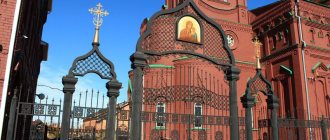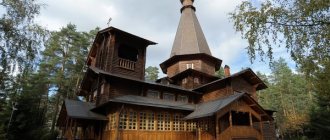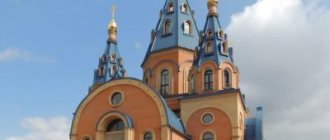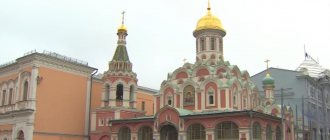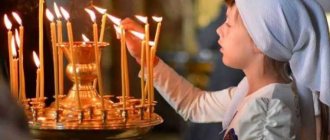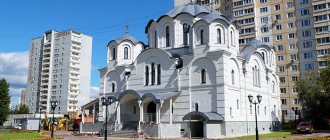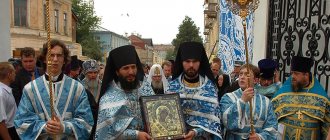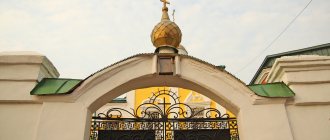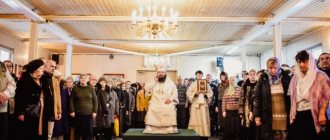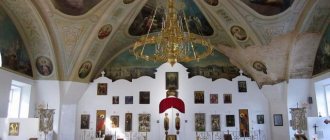"Save me, God!".
Thank you for visiting our website, before you start studying the information, please subscribe to our Orthodox community on Instagram, Lord, Save and Preserve † - https://www.instagram.com/spasi.gospodi/. The community has more than 60,000 subscribers. There are many of us like-minded people and we are growing quickly, we post prayers, sayings of saints, prayer requests, and timely post useful information about holidays and Orthodox events... Subscribe. Guardian Angel to you!
The Temple of the Kazan Mother of God in Kolomenskoye is a treasure of ancient Russian architecture. The church has been decorating Kolomenskoye for three and a half centuries. This is a masterpiece of Russian architecture and historical cultural heritage.
Sights and shrines of the Temple of the Kazan Icon of the Mother of God in Kolomenskoye
While walking through Kolomna Park, be sure to visit the Temple of the Kazan Icon of the Mother of God .
This unique church, built by the first Romanov tsars, remembers many historical events. It has survived to this day in its original form, all this time continuing to serve for the benefit of its community. In addition, the temple protects a shrine that is of great importance both for the Russian state and for the Orthodox Church. I also had a chance to visit this amazing place.
This story will be about what kind of shrine this is, as well as about the history and modernity of the Temple of the Kazan Icon of the Mother of God.
Where is
- The Temple of the Kazan Icon of the Mother of God in Kolomenskoye is located at the address: Moscow, Andropov Avenue 39, building 9.
- Phone +74996152390.
- If you travel by public transport, you need to take one of the city bus routes - 219, 608, 820, 263, 299, 291, 701 - and go to the Kolomenskoye Museum .
Enter the museum grounds, proceed about three hundred meters and turn right through the gate. - The closest metro station to the temple is Kolomenskaya . From there you will need to take buses No. 219, 608, 820.
- If you are traveling by private car, from the Moscow Ring Road turn onto Varshavskoe Shosse , then turn right onto Kolomensky Proezd and, ultimately, you will reach your destination.
The temple is open daily.
- From Tuesday to Thursday from 8 to 16 hours.
- From Friday to Sunday from 8 to 19 hours.
- On Monday from 8 to 12 o'clock.
Schedule of services in the Kazan Church in Kolomenskoye
Services in the temple are held on a regular basis.
- From Monday to Thursday: at 8 o'clock - morning liturgy.
- On Friday and Saturday: at 8 o'clock - morning liturgy, at 17 o'clock the beginning of the evening service.
- On Sunday: at 8:30 – morning liturgy, at 17:00 the beginning of the evening service.
- On the twelve holidays: at 7 o'clock - early liturgy, at 9:40 - late liturgy, at 17 o'clock - evening service.
Interesting facts from the history of the Temple of the Kazan Icon of the Mother of God in Kolomenskoye
- Kolomenskoye has long been a royal possession. Therefore, the first wooden church was built here under the first Romanov ruler, Mikhail, in the 30s of the 17th century.
- In 1649, the next tsar, Alexei Mikhailovich, gave birth to an heir, Dmitry.
This happened on the feast day of the miraculous icon of the Mother of God of Kazan. In this regard, the tsar ordered nationwide celebrations, as well as the construction of temples in honor of the image, including the temple in Kolomenskoye, founded on the site of an old wooden church. It took four years to build the temple. It became the home church of the royal family and was even connected to the sovereign's chambers by a passage. - At the end of the 18th century, Kolomenskoye ceased to be a royal residence. The palace lost its significance and was dismantled, and the temple became the center of the village parish.
- It is interesting that for a long period, until the beginning of the 20th century, the temple did not have interior paintings. It was applied only in the 1910s.
- The temple did not stop worshiping either during the revolution and the Civil War, or in the initial period of Soviet power, when churches were closed en masse and priests were persecuted. Only in the first, most alarming years of the invasion of the fascist invaders, the temple was closed. But he soon resumed his activities, which he has not stopped to this day.
- The Kazan Church was built in Kolomenskoye in a style typical of 17th-century architecture. It was erected on a high plinth and has a circular gallery around the building. The dome of the bell tower is made in the form of a tent.
- The building is crowned with five chapters.
- The main shrine of the temple is the “Sovereign” icon of the Mother of God, the centenary of the miraculous discovery of which was recently solemnly celebrated.
- Also, visitors in one of the chapels of the temple can observe a sculpture of Jesus Christ made of wood. This is a unique shrine, given that a sculptural image of the Savior is atypical for Orthodox churches.
Photo of the temple
With its interior, the Kazan Church in Kolomenskoye resembles a tower.
And so, in a completely different way, the temple looks from a different angle. A solemn service in honor of the centenary of the main shrine of the temple - the “Sovereign” icon of the Mother of God.
This is what the temple looked like in the old days.
And here is the miraculous “Sovereign” Icon of the Mother of God. The Church of the Kazan Icon of the Mother of God in Kolomenskoye now looks very beautiful inside.
Video - Temple of the Kazan Icon of the Mother of God in Kolomenskoye
The first thing a traveler pays attention to when getting to know a new place is the interior. In this regard, the Temple of the Kazan Icon of the Mother of God in Kolomenskoye looks fascinating. You immediately notice the ancient, even, one might say, chronicle architecture. It is very pleasant to be inside the temple. Everything is quiet, measured and without excesses.
I definitely recommend visiting this temple, and then sharing your feelings with us.
Source: https://www.lifejourney.club/evropa/russia/religion/tserkvi-xramy-sobory/moskvy/xram-kazanskoj-ikony-bozhiej-materi-v-kolomenskom.html
Story
Kolomenskoye Park was the former residence of the royalty of the Russian state. The idea of building a church came to Tsar Mikhail Fedorovich after liberation from the Swedish-Polish invasion. But the cathedral was erected during the time of his son Alexei Mikhailovich, when the heir to the throne was born. In Kolomenskoye, in 1667, a new wooden palace was built, which, together with the erected temple, formed a single complex.
Some historical data indicate that the church was erected in honor of the centenary of the capture of Kazan, others that it was founded by Mikhail Fedorovich, and the illumination took place during the reign of his son.
A building was erected on the site of the Kazan Church, where False Dmitry II once hid. This is what prompted the king to make a monument to the events of past years, remove the old structure and build a new one.
The best article for you, go to: Temple “Joy of All Who Sorrow” on Ordynka
The changes did not affect the church tent structure, and it currently represents its original appearance. Under the cross there is an inscription that the temple was built on the site of a wooden church as a tribute to the victory over the Kazan principality a hundred years ago. Historical data matches. Kazan was conquered in 1552, and in 1669 Tsar Mikhail Fedorovich issued a decree on the veneration of the Blessed Virgin Mary. Construction was completed four years later.
After the death of Alexei Mikhailovich, the significance of the cathedral fades away. In the seventeenth century, Kolomenskoye ceased to be a state residence. In the second half of the nineteenth century, the summer palaces began to be removed, and the temple became a parish church.
In the twenties of the last century, the cathedral was closed and a museum was opened.
The church is currently open daily from 07:30 to 20:00. The schedule of services at the Kazan Church in Kolomenskoye is indicated at the entrance.
There is an adult baptismal font, a church Sunday school and a library.
When can you get to the Church of the Kazan Icon in Kolomenskoye: exact schedule
Reigning persons are God's anointed. The life of a sovereign is closely connected with God. The monarch's family always had a church, where significant state events were celebrated with services. For several generations of Russian tsars, the Church of the Kazan Icon of the Mother of God in Kolomenskoye was considered a house church.
Back to the past
In the 16th century, a country residence of Russian autocrats was established in Kolomna. In 1532, Vasily III feasted for three days in the new palace during the consecration of the Ascension Church. Ivan the Terrible celebrates his name day here on August 29 every year. Alexey Mikhailovich erects new chambers in 1649.
On the feast of the Kazan Mother of God, October 22, 1648, Tsarevich Dmitry, the first son of Tsar Alexei, was born. A year later, a royal decree was issued on the widespread veneration of the icon in honor of the Kazan Mother of God. The construction of a house church in honor of the Most Pure Virgin begins.
Historical chronicles do not indicate the exact date of construction of the Church of the Kazan Mother of God in Kolomenskoye. It is only known that in 1650, the elder of the carpenters, Ivanov, received fabric as a reward for the arrangement of the Kolomna Kazan Church.
note
When Moscow was occupied by Napoleonic army, the regiments of Marshal Murat were quartered in Kolomna. The soldiers came to the church not to pray, but to steal. Through the prayers and entreaties of Father Afanasy (Ipatiev), the French nevertheless returned some of the stolen valuables.
During the rampant Bolshevik atheism, the Church of Our Lady of Kazan briefly interrupted the spiritual care of believing parishioners. The authorities closed the temple before the start of the Great Patriotic War. Services resumed in January 1943.
Recent history
The house temple of the royal family, built in the Russian pattern style, has two floors. On the top floor there is the main altar in the name of the Kazan Icon and side chapels: St. Averky of Hierapolis and the Martyr Demetrius of Thessalonica. On the ground floor there is a baptismal church in honor of the “Sovereign” icon.
The pillarless building is decorated with five domes. Two more domes of smaller height rise above the side aisles. A hipped bell tower rises above the northern porch.
The cathedral preserves the following relics:
- miraculous icon “Sovereign”;
- a locally revered list of the Kazan icon of the 18th century;
- the holy image of the 17th century “The Last Judgment”;
- miraculous icons “Iverskaya” and “Fedorovskaya”, made in the 18th century.
"Sovereign"
The Virgin Mary appeared twice to Evdokia Andrianova. On February 13 and 26, 1917, in a dream vision, the Mother of God ordered the woman to find the holy face in the white cathedral.
A pious parishioner came to the Ascension Church in Kolomenskoye. Evdokia asks the rector, Father Nikolai (Likhachev), to help in searching for the shrine.
A smoked icon was found in the basement; this most important event occurred on March 2, 1917, the day of Nicholas II’s abdication from the throne.
When the holy image was washed, the Queen of Heaven appeared to the eyes of the investigators, sitting on a throne with the Child on her lap. The crowned Mother of God in a scarlet robe holds a scepter and orb. The Savior blesses with his right hand, his left palm points to the orb. The semicircular upper part depicts the God of Hosts.
The lower part of the wooden icon measuring 141 x 86 cm was damaged by rot. A piece 20 centimeters wide had to be sawed off. Therefore, the image of the Mother of God does not have feet. After finding the holy face, the nuns of the Alekseevsky Monastery carried out restoration and enclosed the relic in an icon case.
During the years of Bolshevik rule, the icon was kept in the reserve funds of the Historical Museum. In 1990, “Derzhavnaya” returned to the Kazan Church. At the beginning of the 21st century, the holy face made two trips around the world, visiting Orthodox parishes in Europe, America and Australia.
How to attend a worship service
Opening hours of the Church of the Kazan Icon of the Mother of God are Tuesday, Wednesday and Thursday from 8:00 to 16:00, and on Friday and Saturday until 19:00. On Sundays the doors are open from 7:00 to 19:00. On Monday you can visit from 8:00 to 12:00, because general cleaning of the premises begins at noon.
The start of morning services is scheduled for 8:00, evening - at 17:00. Sunday liturgy takes place from 9:00. A detailed schedule of services for each day is presented on the temple website. On the days of great church holidays, the time for the consecration of fruits, products and objects is indicated.
The Church of the Icon of Our Lady of Kazan is located at: Andropova Avenue, building 39, building 9. To visit the church, you need to take the metro to the Kolomenskaya station. From here, take buses following routes 820, 608 or 219 to the Kolomenskoye Museum stop. After walking 100 meters in the opposite direction, visitors enter the territory of the museum reserve.
Important
The Kazan Church is not limited to holding services. Kolomna parish leads an active social life:
- Children's Sunday school is attended by children and teenagers aged 5 to 17 years. Students become acquainted with the basics of Orthodoxy, engage in artistic creativity, and acquire choral singing skills.
- In Sunday school for adults, the Old Church Slavonic language and interpretation of the Bible are studied.
- Together with the bishop's choir of the church, an amateur choir made up of parishioners participates in Sunday services. The audition and selection of candidates is conducted by regent N.A. Myshkin.
Source: https://religiya.guru/hramy-i-monastyri/hram-kazanskoj-ikony-v-kolomenskom.html
Temple of the Kazan Icon of the Mother of God in Kolomenskoye in Moscow
day and night
| February | -3°C | -8 °C |
| March | +4 °C | -3°C |
| April | +12 °C | +3 °C |
| May | +21 °C | +10 °C |
| June | +23 °C | +13 °C |
| July | +26 °C | +16 °C |
Photo from wikipedia.org, author A.
Savin (userpage · contact)
Temple of the Kazan Icon of the Mother of God
- a pillarless five-domed church of the mid-17th century, located on the territory of the State Historical and Architectural Museum-Reserve Kolomenskoye, in the Nagatinsky Zaton district, Southern Administrative District of Moscow, in the former village of Kolomenskoye near Moscow.
Orthodox Church of the Danilovsky Deanery of the Moscow Diocese.
South aisle of St. equal to Averky of Hierapolis, northern - martyr. Demetrius of Thessalonica. The main shrine is the “Sovereign” icon of the Mother of God.
Story
In 1649, in connection with the birth of the heir to the throne, Dmitry Alekseevich, church-wide veneration of the Kazan Icon of the Mother of God was established.
At the same time, stone Kazan churches were founded in the Yaroslavl Kazan Monastery and at the royal Kolomna Palace.
The construction of the existing brick building in Kolomenskoye on a high basement with a hipped bell tower was completed in four years.
In P. G. Palamarchuk’s book “Forty Forties” it is stated that “under the cross of the church there was an inscription that it was built in honor of the 100th anniversary of the capture of Kazan” on the site of an earlier wooden church.
View of the village of Kolomenskoye, approx. 1800
According to later legend, the first Kazan temple in the Sovereign's courtyard was built under Tsar Mikhail Fedorovich in the 1630s. Another version of church tradition says: “In 1610.
the Tushino impostor with the governor Sapega had their camp here.
Tsar Mikhail Feodorovich, in memory of the deliverance of Moscow from the Poles, ordered the foundation of a stone five-domed church in the name of Our Lady of Kazan, consecrated under Alexei Mikhailovich.”
Around 1910, new paintings were applied to the walls of the temple, “originally devoid of any painting.” In 1941-1942 the temple was not in operation, then services resumed and never stopped.
Architecture
Initially, the temple was a house temple and was connected by a passage about 50 m long and about 3 m wide with a wooden royal palace. The covered passage was described as follows by Polish ambassadors who visited Kolomenskoye in 1671.
| at the beginning the church is made of stone with vestibules on both sides with windows half a quarter arshin wide, bridges lined with felt for warmth and soft walking |
The northern porch simultaneously serves as the base of the bell tower and the transition into it.
Temple shrines
- Miraculous Icon of the Mother of God “Sovereign”
- A revered copy of the Kazan Icon of the Mother of God (XVII century).
In the northern aisle there is a wooden sculpture of Jesus Christ. In the 1920s the sculpture was in the main temple.
Source: https://tropki.ru/rossiya/moskovskaya-oblast/moskva/hram-kazanskoy-ikony-bozhiey-materi-v-kolomenskom
Current state[edit]
There is a Sunday school at the Church of the Kzan Icon of the Mother of God in Kolomenskoye.
Description[edit]
The artistic significance of the Kazan Church, which was previously directly part of the sovereign's palace, with which it was connected by covered passages, is small. For this reason, she shows us the most typical, well-developed church building of the second half of the 17th century, examples of which we find quite a large number both in Moscow and in the provinces. The building is a slightly elongated cube, placed on a high basement with porches tilted to the south and north. The solution of the wall plane, reduced to two fundamental techniques, is carried out in accordance with the developed canon. Four closely adjacent windows on each side, excluding the blind eastern one, occupy the middle of the space of the wall, enclosed at the corners by ordinary double pilasters supporting a cornice.
The wide belt of the upper part consists of three cornices one above the other. Above is a line of kokoshniks, which have lost all constructive meaning due to the hipped roof, interrupted by two small windows. Small skinny kokoshniks are covered with a cornice on top so that they are clamped. Window frames with heavy columns also end with kokoshniks. The five-domed structure on thin necks is a decorative superstructure that expresses the temple idea and has absolutely no practical significance, thanks to the blind domes that do not illuminate the interior. On both sides - northern and southern - there are small cubes of two aisles, topped with domes similar to the side domes of the central cube. On a basement made of massive pillars with arches thrown over them, there is a circular gallery covering the church on all sides. It also has pillars and arched joints corresponding to the basement.
Picturesquely spread out porches with water lilies supporting arches and several lockers are themselves quite common; but the northern solution, due to its principled approach, is perhaps the only one in ancient Russian architecture. A bell tower was erected on this porch, which turns out to be, among other things, on the illegal side. Taken in isolation, the bell tower again resembles a well-known and preserved type. On two simple quadrangles, of which the upper one is cut through by a window in a modest frame with a sandstone, an octagon with arched spans raised in the center is erected, topped with an octagonal tent with a small dome on a thin neck; one row of rumors encircles the lower part of the tent. Despite the relatively late date, the bell tower gives a somewhat archaic impression with its discreet design.
The interior of the church with two round pillars has not retained its ancient appearance at all. The current painting, which appeared about fifteen years ago, has completely changed the effect of the walls, which were initially devoid of any painting.
The five-tiered iconostasis is also of recent origin; Some icons of the 17th century remained in it, however, they were written down.
Temple of the Kazan Icon of the Mother of God in Kolomenskoye
The Church of the Kazan Icon of the Mother of God in Kolomenskoye, erected in the 1640s, was not closed by the Bolsheviks. Service stopped only in the first two years of the Great Patriotic War, when the front-line zone was located here. By some miracle, the Kazan Church survived the fire that destroyed the wooden royal palace of Alexei Mikhailovich Romanov.
The five-domed Church of the Kazan Icon of the Mother of God in Kolomenskoye is one of the most valuable buildings on the territory of the museum-reserve.
The photo from the drone clearly shows the location of the temple relative to the natural landscape and man-made objects on the western bank of the Moscow River.
Advice
The highest landmark is the even more ancient Church of the Ascension of the Lord, dating back to 1532. The foreground of the photograph is occupied by rows of apple trees in the Voznesensky Garden, restoring the appearance of the area before the fire.
The Royal Palace was 50 meters closer than the Church of the Kazan Icon of the Mother of God in Kolomenskoye. This was the house church of the residents of the residence; the buildings were connected by a covered passage.
We have already visited the restored palace of Tsar Alexei Mikhailovich in Kolomenskoye. It can be seen in the new location behind the church; they did not begin to build on the old location.
The reason for this was the centuries-old oak grove that grew on the surviving palace foundations.
Temple of the Kazan Icon of the Mother of God from the side
Muscovites and visitors visiting Kolomenskoye can stroll through the territory traditionally called the Sovereign's Courtyard. Would anyone dare to destroy wonderful trees two hundred years old? In this case, changing the historical truth for the sake of preserving nature is completely acceptable and completely justified.
In its immediate surroundings, the Church of the Kazan Icon of the Mother of God in Kolomenskoye has several other attractions worthy of visiting. This is, first of all, the mentioned Cathedral of the Ascension, the first tented temple made of stone in Rus', protected by UNESCO. Nearby is the water cocking tower and the house of Peter I in Kolomenskoye.
The cylindrical drums of the five-domed temple, placed almost close to each other, are crowned with sky-colored domes studded with stars. For churches dedicated to the Mother of God, this is the canonically correct type of decoration. The star of Bethlehem, lit in honor of the birth of the Savior, is symbolized by the stars on the domes.
The heads of the main volume of the temple are located on the quadrangle of the second tier, the lower one is much larger. Upon careful examination, a holy image can be discerned on the right side of the building above the arch. This is a copy of the icon of the Mother of God Sovereign, which is kept by the Church of the Kazan Icon of the Mother of God in Kolomenskoye along with a copy of the title image.
Panorama outside and inside the temple, photos of the surrounding area
Panoramic photography with an all-round view allows you to examine in detail the Church of the Kazan Icon of the Mother of God in Kolomenskoye and its immediate surroundings.
The image can be zoomed in and out by clicking on the signs in the upper left corner. Of particular interest is the hipped porch with a canopy on brick columns of variable cross-section.
When rotating the image, a park area with benches and numerous visitors also comes into view.
note
In addition, clicking on the arrow in the pulsating circle allows you to inspect the interior. The Church of the Kazan Icon of the Mother of God in Kolomenskoye is equipped with a richly gilded iconostasis separating the altar space. By turning, holy images, gilded candlesticks and other church equipment are introduced into the field of view.
Returning to the inspection of the park area, we will walk along the alleys and look at the trees and grass carpet. It becomes clear that destroying such beauty for the sake of restoring the palace would be a real crime. Some displacement of the historical life-size model will soon be forgotten, but the natural beauty will be preserved for a long time.
From the side of the royal palace, newly built according to the drawings made at the behest of Catherine the Great and preserved to this day, the Church of the Kazan Icon of the Mother of God in Kolomenskoye looks very impressive. The alleys among the apple orchards, round at the intersections, are equipped with comfortable benches for comfortable rest.
The preservation of ancient monuments of church architecture is not only of godly significance, it is important for all citizens, regardless of their attitude to faith and professed religion. This is a full-fledged layer of our history, a national treasure and the pride of the nation. Having visited the Church of the Kazan Icon of the Mother of God in Kolomenskoye, you feel this especially clearly.
Source: https://countryscanner.ru/khram-kazanskoy-ikony-bozhiey-materi/
Temple of the Kazan Icon in Kolomenskoye | Kazanskaya
Description:
Since the 15th century With. Kolomenskoye was the royal estate. The temple on a high basement with a hipped bell tower was built in 1649-1653. under Tsar Alexei Mikhailovich in honor of the 100th anniversary of the capture of Kazan. It was connected by a passage with the wooden royal palace, which was dismantled in the 19th century due to its disrepair. In 1941-1942 the temple did not function, then the services resumed and did not stop.
The main one is the Kazan Icon of the Mother of God, the chapel is St. equal to Averky of Hierapolis and the Great Martyr. Demetrius of Thessalonica.
The miraculous Icon of the Mother of God “Sovereign” (found on March 15, 1917 and returned to the temple on July 27, 1990); revered Kazan Icon of the Mother of God (XVII century).
- Archpriest Vladimir Gontar - rector
- Priest Alexy Moiseev
- Priest Theodore Romanenko
- Priest Timofey Kurapatov
Divine service
Daily - Liturgy at 8.00, Vespers, Matins - at 17.00, on Sundays and holidays - Liturgy at 7.00 and 10.00, the day before - all-night vigil at 18.00, on Sundays at 17.00 - water blessing prayer with an akathist to the Kazan Icon of the Mother of God, on Friday - prayer with Akathist to the “Sovereign” Icon of the Mother of God.
The temple is open from 7.30 until the end of the evening service.
There is a Sunday school and library. There is a baptistery for adult baptisms.
A country:
Russia
City:
Moscow
Address:
115487, prosp.
Andropova, 39, building 9 Phone: Website:
https://kolomenskoe.prihod.ru/
(Southern District)
In 1651, under Tsar Alexei Mikhailovich, a seven-domed temple with a hipped bell tower, on a high basement, was consecrated, which later became part of the wooden royal palace. In 1941-1942 the temple was closed, then services resumed and never stopped.
Thrones
Shrines:
- Miraculous Icon of the Mother of God "Sovereign"
- Revered Kazan Icon of the Mother of God
Address, telephone numbers and directions
Driving directions
from the site nakarte.ru:
Schedule
. daily Liturgy at 8 o'clock. Vespers, matins at 17 o'clock on Sunday. and holiday – two Liturgies at 7 and 10 a.m. the day before all-night vigil at 6 p.m. (in winter at 5 p.m.).
Clergy:
The rector is Rev. Svyatoslav Yurimsky, prot. Nikolai Mikhnyuk, priest Sergius Stepanov, priest Sergius Dementyev.
Attention!
Clergy membership and service schedule information may be out of date.
Source: https://www.tsurganov.info/kazanskaja/hram-kazanskoj-ikony-v-kolomenskom.html
Building style
This is a pillarless five-domed temple with a circular gallery, arched connections and staircases. Many designs served a decorative role. The walls of the temple were decorated with rich paintings, they were draped with expensive carpets and materials, and the icons were framed with towels. The floor covering of the cathedral was felt.
The best article for you, go to: Alexander Nevsky Temple at MGIMO
The Church of the Icon of the Mother of God in Kolomenskoye was assigned the role of a family church at the palace chambers. The cathedral was connected by a gallery to the palace of Alexei Mikhailovich, and it was convenient. The length of the passages to the palace was 50 meters and the width was 3 meters. When the royal palace was moved to another place, the cathedral became the church monastery of Kolomenskoye.
The dignity of the building lies not in the originality of the architecture, but in the perfection of the style of Russian Orthodox architecture.
Shrines:
- miraculous image of the Mother of God “Sovereign”,
- list of the image of the Kazan Icon of the Mother of God,
- holy relics of Sergei Voskresensky and Leonty Strotsyuk,
- An ancient sculpture of Christ in prison is, as it were, an atypical attribute for Russian churches.
